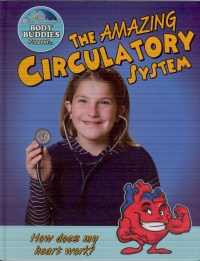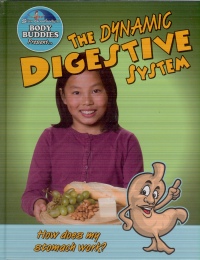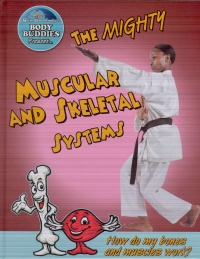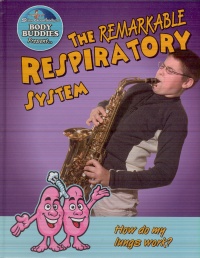| ________________
CM . . .
. Volume XV Number 18. . . .May 1, 2009 
 |
The Amazing Circulatory System: How Does My Heart Work? (Slim Goodbody's Body Buddies).
John Burstein.
St. Catharines, ON: Crabtree, 2009.
32 pp., pbk. & hc., $9.95 (pbk.), $20.76 (RLB).
ISBN 978-0-7787-4431-3 (pbk.), ISBN 978-0-7787-4417-7 (RLB).
Subject Headings:
Cardiovascular system-Juvenile literature.
Blood-Circulation-Juvenile literature.
Grades 4-5 / Ages 9-10.
Review by Gail Hamilton.
** /4
|
| |
|
 |
The Astounding Nervous System: How Does My Brain Work? (Slim Goodbody's Body Buddies).
John Burstein.
St. Catharines, ON: Crabtree, 2009.
32 pp., pbk. & hc., $9.95 (pbk.), $20.76 (RLB).
ISBN 978-0-7787-4428-3 (pbk.), ISBN 978-0-7787-4414-6 (RLB).
Subject Headings:
Nervous system-Juvenile literature.
Brain-Juvenile literature.
Grades 4-5 / Ages 9-10.
Review by Gail Hamilton.
** /4
|
| |
|
 |
The Dynamic Digestive System: How Do My Lungs Work? (Slim Goodbody's Body Buddies).
John Burstein.
St. Catharines, ON: Crabtree, 2009.
32 pp., pbk. & hc., $9.95 (pbk.), $20.76 (RLB).
ISBN 978-0-7787-4429-0 (pbk.), ISBN 978-0-7787-4415-3 (RLB).
Subject Headings:
Gastrointestinal system-Juvenile literature.
Digestion-Juvenile literature.
Grades 4-5 / Ages 9-10.
Review by Gail Hamilton.
** /4
|
| |
|
 |
The Exciting Endocrine System: How Do My Glands Work? (Slim Goodbody's Body Buddies).
John Burstein.
St. Catharines, ON: Crabtree, 2009.
32 pp., pbk. & hc., $9.95 (pbk.), $20.76 (RLB).
ISBN 978-0-7787-4432-0 (pbk.), ISBN 978-0-7787-4418-1(RLB).
Subject Heading:
Endocrine glands-Juvenile literature.
Grades 4-5 / Ages 9-10.
Review by Gail Hamilton.
** /4
|
| |
|
 |
The Mighty Muscular and Skeletal Systems: How Do My Bones and Muscles Work? (Slim Goodbody's Body Buddies).
John Burstein.
St. Catharines, ON: Crabtree, 2009.
32 pp., pbk. & hc., $9.95 (pbk.), $20.76 (RLB).
ISBN 978-0-7787-4433-7 (pbk.), ISBN 978-0-7787-4419-1 (RLB).
Subject Headings:
Musculoskeletal system-Juvenile literature.
Skeleton-Juvenile literature.
Bones-Juvenile literature.
Grades 4-5 / Ages 9-10.
Review by Gail Hamilton.
** /4
|
| |
|
 |
The Remarkable Respiratory System: How Do My Lungs Work? (Slim Goodbody's Body
Buddies).
John Burstein.
St. Catharines, ON: Crabtree, 2009.
32 pp., pbk. & hc., $9.95 (pbk.), $20.76 (RLB).
ISBN 978-0-7787-4430-6 (pbk.), ISBN 978-0-7787-4416-0 (RLB).
Subject Headings:
Respiratory organs-Juvenile literature.
Respiration-Juvenile literature.
Lungs-Juvenile literature.
Grades 4-5 / Ages 9-10.
Review by Gail Hamilton.
** /4
|
| |
|

excerpt:
Your thymus is a soft, flat, pinkish-gray gland in your chest. It is located behind your breast bone. Your thymus has two lobes. Each lobe is divided into smaller sections called lobules. Each lobule has an outer covering called a cortex and an inner center called the medulla. When you were born, your thymus gland weighed less than half an ounce (14 g). Your thymus will continue to grow until you reach your teen years. It will then weigh about 1.5 oz (42.5 g). (From The Exciting Endocrine System.)
Fans of the PBS television series, The Inside Story, will be familiar with Slim Goodbody (aka John Burstein) who has authored these six titles about the various human body systems. Each of the books has 14 chapters as well as a table of contents, a glossary and a list of books and web sites for further study. The first two pages of each title are identical, introducing the reader to eight Body Buddies that appear throughout the books to explain certain concepts. Body Buddies are little cartoon figures representing different body organs, some examples being Cognos, who looks like a brain, Ticker, who is a heart, and Huff and Puff, the lungs. Besides the main text, there are instructions for science experiments to try at home, as well as Amazing Facts and Fabulous Phrases, which, in all but one of the books, asks readers to fill in the blanks of sentences with terms pertaining to the featured body system. For instance, in the title about the circulatory system, there are heart terms such as "by heart" and "change of heart." Though the series has some strengths- easy-to-follow diagrams, large text and examples taken from a child's daily life- there are also several weaknesses. Covers are dull and unappealing; there is a definite American slant- from the inclusion of the Food Pyramid and Imperial measurement, to references to saluting the flag; a few of the illustrations are repeated throughout the series; there is some "filler' material; and many of the science "experiments" are quite lame and not really experiments at all. For example, one experiment requires readers to mark their height on a door frame each year to prove that their pituitary gland is working; another asks readers to wash their hands with soap for 20 seconds to stay healthy. But perhaps the main weakness is that the text is somewhat inconsistent. In some parts, it is very juvenile in its vocabulary, while in others, it is very technical, and so it is difficult to ascertain the series' true target audience. Illustrations consist of drawings, diagrams and photographs, including a double-page diagram of the featured body system.
The Amazing Circulatory System features the workings of the heart and blood as well as information about heart health and cholesterol, and the pioneers in heart medicine such as Dr. Christiaan Barnard, who performed the first successful heart transplant, and Dr. Robert Jarvik, who designed an artificial heart.
The Astounding Nervous System highlights the parts of the brain, the functions of the right and left hemispheres, the five senses and the way in which messages are transmitted to and from the brain.
In The Dynamic Digestive System, readers will learn the steps in digestion- from what happens in the mouth to the esophagus, stomach and small and large intestines. The work of the liver and kidneys is also discussed. What is interesting is how the digestive system breaks food down into pieces that are smaller than a period at the end of a sentence in order to be used by the body.
Body Buddy Squirt introduces readers to the pineal, pituitary, thyroid, hypothalamus and adrenal glands in The Exciting Endocrine System. The role of hormones, the effects of glucose, and diseases and disorders such as diabetes and SAD are also discussed.
Different types of bones and joints as well as the three kinds of muscles- and their functions- are the topics of The Mighty Muscular and Skeletal Systems. In the other titles, there is mention of how to keep the featured body system or organ healthy, yet in this title, there is no reference to osteoporosis and bone health or the importance of exercise to keep the body strong.
Huff and Puff, the lung twins, take readers on a journey in The Remarkable Respiratory System. Terms such as trachea, alveoli, bronchi, diaphragm and intercostal muscles are explained. As well, there is information about respiratory illnesses, such as allergies and asthma, and the importance of deep breathing and not smoking.
Generally, "Slim Goodbody's Body Buddies" is a fairly good series, but it requires some careful editing.
Recommended with reservations.
Gail Hamilton is a teacher-librarian in Winnipeg, MB.

To comment
on this title or this review, send mail to cm@umanitoba.ca.
Copyright © the Manitoba Library Association. Reproduction for personal
use is permitted only if this copyright notice is maintained. Any
other reproduction is prohibited without permission.
NEXT REVIEW |
TABLE OF CONTENTS FOR THIS ISSUE
- May 1, 2009.
AUTHORS |
TITLES |
MEDIA REVIEWS |
PROFILES |
BACK ISSUES |
SEARCH |
CMARCHIVE |
HOME |





